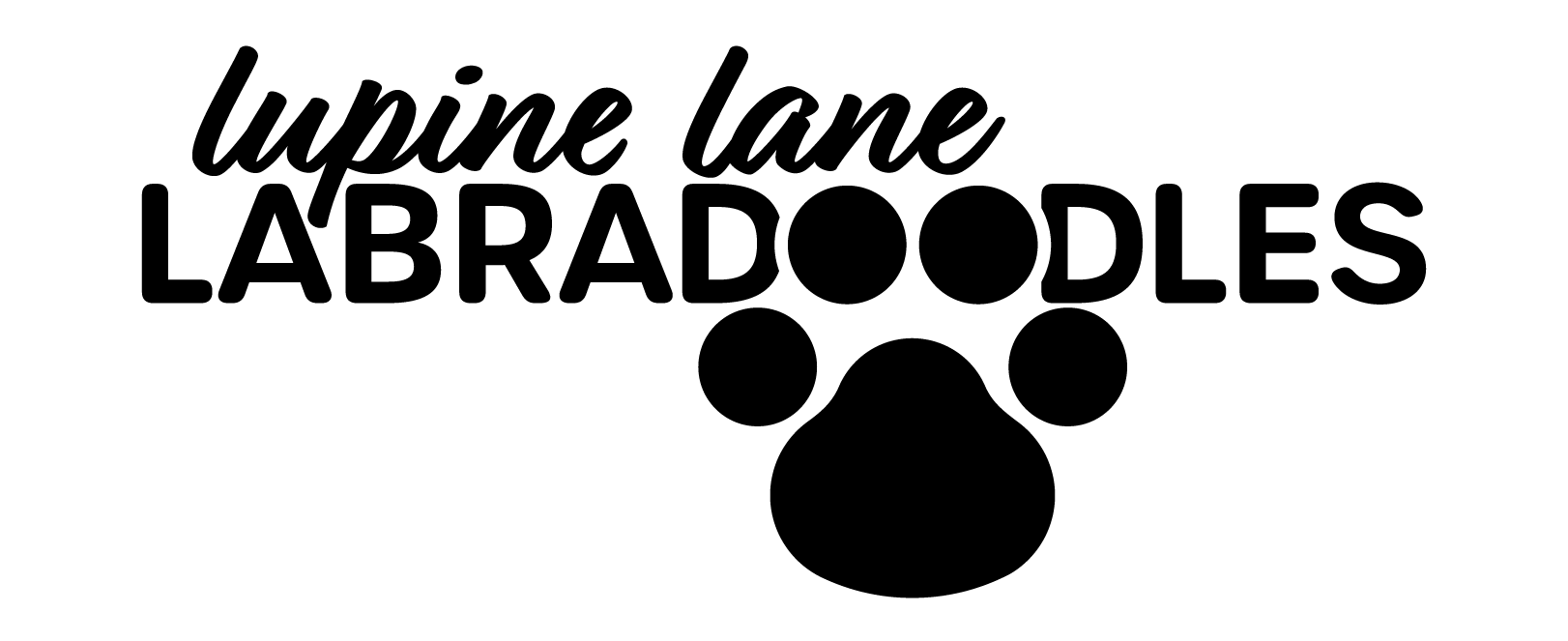What Is an Australian Labradoodle?
Multi-generational Australian Labradoodles are hypoallergenic, affectionate, small- to medium-sized dogs. They are the perfect family pet. To us, they are pure love.
The Australian Labradoodle, named for its country of origin, is considered to be a cross between the Poodle and Labrador Retriever with intermittent infusion (a dash) of Cocker Spaniel or Cockapoo. Don’t be fooled by “Australian” in the name! Australian Labradoodles do not have Australian Shepherd ancestry.
Because of the service dog potential, breeders in Australia began breeding Labradoodles with the hope of producing puppies with consistent conformation, coat type, and temperament.
Temperament
An Australian Labradoodle is a perpetual optimist. Everything is happy in their world. They are jovial, comical and goofy, but also content just to relax with their people. They want to do whatever you’re doing. If the kids are running around playing, that’s what they want to do! If you’re snuggled up with a good book, they will happily curl up beside you. It’s the absolute best of both worlds. Australian Labradoodles love to play and have just the right amount of energy. They are incredibly intelligent and eager to please, which makes them extremely trainable. They need regular exercise, but nothing like the requirements of some of the field hunting breeds. They adore toys! Plush, squeaky, tug, you name it; they love them all. One of my favorite traits of the Australian Labradoodle is their sensitivity toward people. They LOVE their humans and tend to be very in-tune to their needs. This makes them excellent therapy and service dogs candidates. They are fantastic with kids, other animals, and think everyone is their friend.
Size Categories
The Australian Labradoodle has three height categories. Size is measured from the floor to the top of the shoulder.
Miniature: 14-16 inches in height and 15-30lbs in weight.
Medium: 17-20 inches in height and 30-45lbs in weight.
Standard: 21-24 inches in height and 45-65lbs in weight.
Colors
Labradoodle colors vary widely and include solid and parti colors (more than one color). Keep in mind, a pup may not retain their original color. At times, a puppy’s coat will lighten with age but may surprise everyone by darkening. Coat color will range in shade and intensity.
Chalk / White: White does not necessarily mean pure white. Shades can vary from white to cream.
Cream / Gold: This is richer in color than a chalk or white. The color ranges from just hints of gold to deep gold.
Apricot: Visualize the fleshy part of a peach. Apricots can range from a light apricot to dark apricot. Some fade over time and some maintain their color.
Red: Ah, the beautiful red! A real red will be quite dark and red. Many mistake a dark apricot for a red. They can fade to an apricot, but others will retain their deep dark red. Red is one of the more challenging colors to produce.
Caramel: A caramel is an apricot or red with a liver nose and green eyes. A dark caramel can also be a challenging color to produce.
Chocolate: This color can range from dark to milk chocolate. The chocolate color may stay deep or fade over time.
Black: Unlike some of the other colors, true blacks should retain its color. If there are any recessive genes in the line for silver or blue, the pup can fade to silver.
You can find more detailed information on Australian Labradoodle colors HERE
Coats
Australian Labradoodles can have one of three distinct coat types.
Fleece: A wavy to curly coat that has the feel of silky angora. This is typically a non-shedding coat. The coat can be higher maintenance during the transition from puppy to adult dog.
Wool: Curly like a poodle, usually non-shedding and allergy friendly. A wool coat typically has a more cotton-like feel. This coat can be high maintenance if kept long. Clipping it shorter will cut down on the maintenance.
Hair: Varies in thickness and length. Tends to be straight or slightly wavy. The coat is low maintenance. Compatibility with allergy sufferers varies considerably because some pups with this coat type shed more than others.
Life Expectancy
12-15 years
Generations At a Glance
First Generation Labradoodle (F1): The product of a Labrador Retriever crossed with a Poodle. Coats can be somewhat inconsistent at this stage. Approximately 30% either do not shed at all or shed very little. This cross is typically not suited for families with allergies. These coats tend to be easy to maintain.
F1b Labradoodle (F1b): The result of crossing an F1 Labradoodle to a poodle. This combination helps to create a more consistent allergy-friendly coat. The success rate for a light-shedding to a non-shedding dog is much higher.
Australian Labradoodles: The result of crossing an Australian Labradoodle to an F1, F1b or Poodle, or crossing combination of a Labrador, Poodle and Cocker Spaniel. The result of either will be considered an Australian Labradoodle and are typically allergy friendly.
Multigenerational Australian Labradoodle: The result of crossing an Australian Labradoodle to another Australian Labradoodle. This cross is considered allergy friendly.
